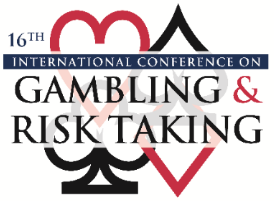Measuring Risk in Adolescents before Harm for Prevention Not Treatment: A New Approach to Risk Assessment for Social Policy, and Prevention Applications
Session Title
Session 1-3-C: Adolescence, Risk, and Gambling
Presentation Type
Event
Location
The Mirage Hotel & Casino, Las Vegas, Nevada
Start Date
7-6-2016 2:00 PM
End Date
7-6-2016 3:30 PM
Disciplines
Child Psychology | Counseling | Economics | Mental and Social Health | Psychology | Public Affairs, Public Policy and Public Administration | Sociology | Statistics and Probability | Substance Abuse and Addiction
Abstract
For the most part, current adolescent screens are adaptations of short screens originally designed to measure problem gambling among adults. Other measures such as the CAGI do not adequately capture risk associated with gambling among youth. The authors, using principles and methods employed in the development of the FocaL Adult Gambling Screen (FLAGS™), developed the Focal Youth Gambling Risk Screen (FYGRS™) designed specifically to identify adolescents at varying degrees of risk due to gambling as well as those who have been harmed or are problem gamblers. FYGRS uses constructs such as: adult facilitation of gambling, the influence of others and peers, opportunities to gamble, risky cognitions beliefs, risky cognitions motives, impaired control, risky practices around gambling, and harms experienced by adolescents caused by their gambling. Collecting such a detailed list of indicators allows for targeted feedback to the youth by counsellors or through documentation if self-administered. It also allows policy makers to identify key factors leading to risk and harms among adolescents and adopt appropriate strategies for dealing with it. The presentation will provide an overview of the process for development of the instrument including testing for validity and reliability. We have completed two phases of research utilizing this instrument and there are several projects going to field to test it further. Results from these recent studies will be discussed and the resulting refinements to the instrument presented.
Keywords
Focal Youth Gambling Risk Screen, FYGRS, adolescent gambling, youth gambling, gambling risk, problem gambling, gambling harms, impaired control, risky cognitions, risky behaviors
Streaming Media
Measuring Risk in Adolescents before Harm for Prevention Not Treatment: A New Approach to Risk Assessment for Social Policy, and Prevention Applications
The Mirage Hotel & Casino, Las Vegas, Nevada
For the most part, current adolescent screens are adaptations of short screens originally designed to measure problem gambling among adults. Other measures such as the CAGI do not adequately capture risk associated with gambling among youth. The authors, using principles and methods employed in the development of the FocaL Adult Gambling Screen (FLAGS™), developed the Focal Youth Gambling Risk Screen (FYGRS™) designed specifically to identify adolescents at varying degrees of risk due to gambling as well as those who have been harmed or are problem gamblers. FYGRS uses constructs such as: adult facilitation of gambling, the influence of others and peers, opportunities to gamble, risky cognitions beliefs, risky cognitions motives, impaired control, risky practices around gambling, and harms experienced by adolescents caused by their gambling. Collecting such a detailed list of indicators allows for targeted feedback to the youth by counsellors or through documentation if self-administered. It also allows policy makers to identify key factors leading to risk and harms among adolescents and adopt appropriate strategies for dealing with it. The presentation will provide an overview of the process for development of the instrument including testing for validity and reliability. We have completed two phases of research utilizing this instrument and there are several projects going to field to test it further. Results from these recent studies will be discussed and the resulting refinements to the instrument presented.

Comments
Audio recording of this presentation is attached as a downloadable MP3 audio file, 46.2 MB.
We presented the results of an earlier phase of this research several years back. We subsequently surveyed 900 adolescents and were able to refine the FYGRS instrument and validate and test the reliability of its constructs. We are currently initiating studies with two adolescent populations to determine the effectiveness of the instrument on informing adolescents about their risk status and motivating them to reduce their risk levels if identified. We hope this presentation will result in other jurisdictions applying the FYGRS instrument to accomplish the same goals.